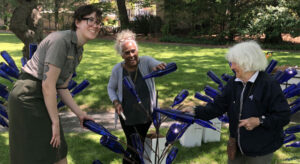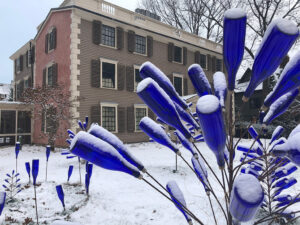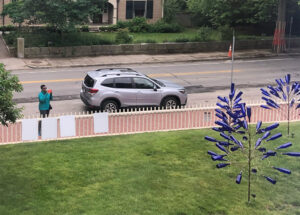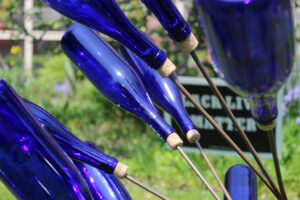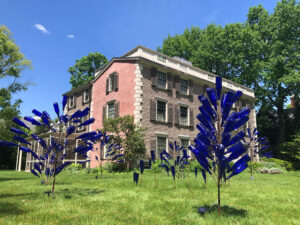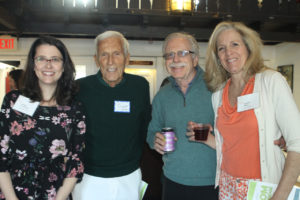Posts Tagged ‘Brattle Street’
April 27: Trouble on Tory Row: A Family Tour of Brattle Street (rescheduled)
Join History Cambridge for a guided tour of Brattle Street’s neighborhood, made specifically for children and families, to learn about the history of the Revolutionary Era here!
Read MoreBottle trees are sprouting up in new locations, continuing to honor the enslaved in Cambridge
If you travel regularly along Brattle Street west of Harvard Square, you may have asked yourself in recent weeks, “Where are the blue bottle trees?”
Read MoreArt installation ‘Forgotten Souls of Tory Row’ coming down, presence of enslaved remains
Visitors are welcomed to the Hooper-Lee-Nichols House for the final week of “Forgotten Souls,” to be removed April 7 as its installation comes to a close.
Read MoreHistory Cambridge plans a celebration Saturday for its ‘Forgotten Souls of Tory Row’ installation
History Cambridge put out a call in February to artists to create a temporary installation on the lawn of our headquarters, the Hooper-Lee-Nichols House, 159 Brattle St., West Cambridge. With support from Cambridge Arts and the Mass Cultural Council, this project’s goal was to honor the enslaved people who lived and worked on Brattle Street. Many of the area’s wealthy homeowners made their wealth through enslaved labor in Jamaica and enslaved people at their homes and estates in Cambridge. Joseph and Rebecca Lee, owners of the Hooper-Lee-Nichols House, were complicit in this economy. We know of at least five individuals – Cesar, Prince, Caesar, Mark Lee (or Lewis) and a woman whose name we do not know – who were enslaved by the owners of the house. Although we have no direct surviving evidence that an enslaved person ever lived there, we know other white Tory Row families enslaved people at their Brattle Street mansions. History Cambridge strives to use its headquarters in a way that recovers and shares the stories of the enslaved people of this land and acknowledges that chattel slavery was a Northern as well as a Southern system.
Read MoreCambridge’s Caribbean connection runs deep
“Forgotten Souls of Tory Row: Remembering the Enslaved People of Brattle Street,” the installation of bottle trees now on view at the History Cambridge headquarters (159 Brattle St.), was inspired by a custom that originated in Congo in West Africa long ago. The tradition of bottle trees was brought to the Caribbean and the Southern United States by enslaved people and passed down through generations. While bottle trees signify different things to different people, there is agreement that the bottles are placed on tree branches to destroy evil spirits and to capture the energy, spirit and memories of ancestors.
Read More‘Forgotten Souls of Tory Row’ art installation remembers enslaved people of Brattle Street
Cambridge and slavery are not often paired in the public imagination. Most think of the enslavement of people of African descent as a Southern phenomenon from which the North, particularly New England, was exempt. But slavery was a very real, ever-present institution in Northern colonies and, later, states – including Massachusetts. Recent efforts by academic and public historians to emphasize the role slavery played in the Cambridge area include the re-centering of Medford’s Royall House and Slave Quarters to focus on the experiences of enslaved people on that estate, as well as Harvard University’s recent release of the “Harvard and the Legacy of Slavery” report. History Cambridge has also been engaged in this important work through our research and public programs, including our Tory Row Antiracism Coalition
Read MoreHistory Cambridge will bring an art installation to Brattle Street to focus on neglected Black past
History Cambridge intends to install temporary public art this spring on the front lawn of the Hooper-Lee-Nichols House, 159 Brattle St., to raise awareness of Black history in West Cambridge. The organization seeks an artist who works or lives in Massachusetts and is sensitive to the connected history of Massachusetts and plantations in the Caribbean to create a site-specific, temporary piece of installation art. Funding comes from Cambridge Arts and the Massachusetts Cultural Council.
Read MoreA Tribute to Preservationist Roger Webb
We were saddened to learn of the passing of historical preservationist Roger Webb, a good friend and long-time member of the Society. We will truly miss his warmth, enthusiasm, and seemingly endless energy. During the course of his long and storied career, Roger facilitated the preservation of numerous historic buildings throughout Massachusetts and the country.…
Read MoreThe Old Hooper-Lee House by Thomas Coffin Amory
From the Proceedings, Volume 16, p. 21-25 [The following is taken, by permission, from the little-known article by Thomas Coffin Amory (H. C. 1830) entitled “Old Cambridge and New,” in the Register of the New England Historic-Genealogical Society for July, 1871. It gives an interesting picture of the house some sixty years ago — very…
Read MoreThe Hooper-Lee-Nichols House by Mary Isabella Gozzaldi
Read April 25, 1922 From the Proceedings, Volume 16, p. 18-20 This house has been sometimes called the oldest house in Cambridge, and its large central stack chimney shows that it belongs to an early period of New England architecture; but it was originally a farmhouse in Watertown, as Sparks street was the westerly limit…
Read More

